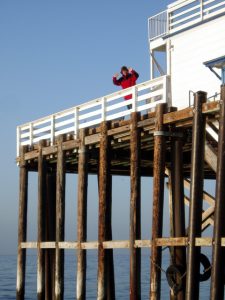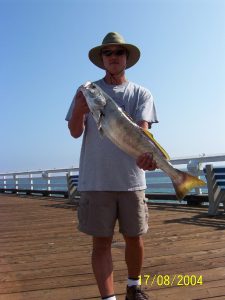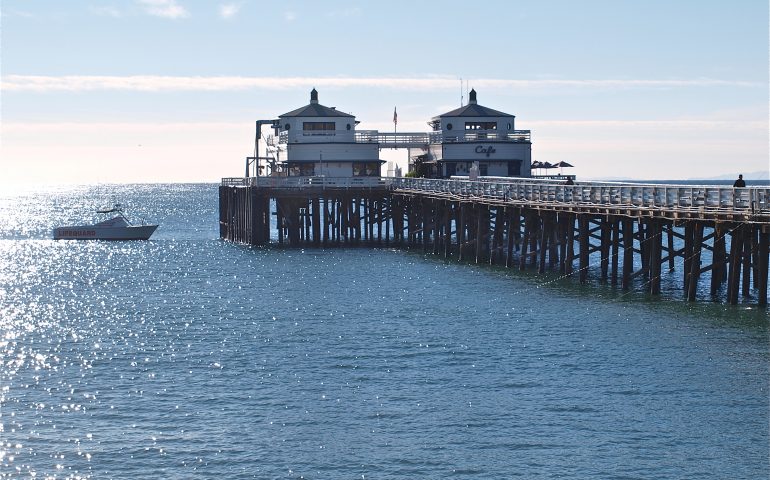September, 2011— Ginny at Wylie’s Bait and Tackle says he main news probably is the numbers of threshers being taken from the end of the pier. Fish are being caught pretty much everyday and some have been fairly large with one reported at 120 pounds. It’s also been an unusually good year for corbina inshore and she measured one at 3 pounds 12 ounces (big for that area). Finally, there are quite a few perch and good numbers of mackerel but it’s slow on the halibut.
September, 2013—Ginny at Wylie’s Bait and Tackle says it’s been a mixed bag this month. Anglers have reported yellowfin croaker, big bat rays, fewer but larger lizardfish, and quite a few short halibut (along with a keeper 27” fish). She’s also heard reports of corbina in the surf. Her regulars tell her the key to the halibut is to use Lucky Craft lures for the halibut (and we’ve heard this before). Ginny believes the top model is the Flash Minnow 110 and the top colors are Metallic Sardine, MS Anchovy, and the Ghost Minnow. [I might add that some anglers who use these lures tell me they are great BUT that the hooks will often bend with large fish. Many people remove the original hooks and replace them with something stronger, i.e., Gamakatzu hooks. But, it seems a $20 lure should come with strong hooks.] She also says the end of the pier is closed once again due to fire worries and damage. Both restaurants on the pier have closed and the Sportfishing operation is not running a boat this season.
They say there’s no such things as problems, only opportunities, but it sometimes seems like the financial and infrastructure opportunities at this pier never stop.
Special Recommendation. Because of elevated levels of DDT and PCB, the Cal OEHHA recommends that anglers limit themselves to one meal a month of queenfish caught from the Malibu Pier.

Potpourri — Perhaps more than you want to know about the Malibu Pier
<*}}}}}}}}}>< — For some reason, the Malibu Pier was a pier that I had never fished until the mid-1980s. I had driven by the pier many times, stopped and taken pictures a few times and, of course, conversed with the fishermen, but I had never actually fished on the pier. Finally, I decided I needed to fish it if I was going to write about it and in August of 1984, my son Mike and I made it to Malibu. It was fairly late in the afternoon and we were tired. We had fished during the morning at Hermosa Beach, caught a fair number of mackerel, queenfish and salema, and we were only going to fish a short time before proceeding on to our motel. We did not anticipate the fishing we would see at the pier. After finding a parking space (no easy task), we headed out to the end of the pier.
Live anchovies seemed to be catching fish so we bought some. For a half hour, there was only sporadic action; Mike had caught three mackerel, and I had caught two mackerel and a small kelp bass. Soon after this, a nearby angler caught a sea trout (small white seabass) and then a second was caught. Pretty soon it seemed every angler was hooked up to a mackerel or to a white seabass. Mike and I were using fairly light tackle so we had a blast. Mackerel were slashing through schools of bait; white seabass seemed to be following after the mackerel, and then some boneheads—bonito, showed up. Live bait, spoons, feathers—anglers were casting whatever they had into the water and whatever they had seemed to be working. For two hours everyone seemed to catch fish; it was a primeval carnage of the first degree.
Then the action stopped; mackerel, bonito, and white seabass moved on. Fish, bags of fish, and buckets filled with bloody water and even more fish, covered the surface of the pier. But the only anglers still catching fish were a few lonely ones working the surf area and even they had a few fish (mainly corbina) to show for their efforts. Mike and I hauled our arm-weary bodies down the road.
Since then I have fished the pier more than twenty times but results have never come close to duplicating that spectacular visit. Nevertheless, the memories and the excitement of that visit still linger and perhaps explain why a visit to this pier is always an eagerly anticipated event.
The story, by the way, may answer an old question in regard to fishing pressure and does it really impact the number or type of fish caught? The El Niño storms of 1983 forced the closure of this pier for nearly a year and a half and anglers were not permitted to fish on the pier (since it was dubbed unsafe). But fishing did continue. Unknown to most people, a few of the people who had worked at the pier still had access and continued to fish. The stories of white seabass and yellowtail caught at the pier (including seven yellowtail in one day by one angler) are pretty impressive. So too were the number of large fish caught at night, including some good-size sharks and even a salmon.
Even though it’s true that this was an El Niño, warm water period, I don’t believe the catches would have been duplicated if the pier were open. With a lack of fishing pressure, the smaller species probably multiplied around the pier and wherever there are smaller fish there will be larger fish. Looking back, I can also see that my first visit, discussed above, must have occurred shortly after the pier was reopened. Perhaps that explains the extraordinary success of that day.
<*}}}}}}}}}>< —Fish and Game fish surveys done at the pier from 2004-2009 give evidence of the most common species (24). The fish (listed numerically) — walleye surfperch, Pacific mackerel, jacksmelt, Pacific sardine, yellowfin croaker, black perch, shiner perch, white seaperch, Pacific bonito, rubberlip seaperch, jack mackerel, California halibut, shovelnose guitarfish, topsmelt, California corbina, white seabass, cabezon, barred surfperch, pile perch, sargo, salema, thresher shark, leopard shark and bat ray.
<*}}}}}}}}}>< — The state record bonito, a fish weighing 22 lb 3 oz, was caught at Malibu on July 30, 1978 by Gino Piccolo.
<*}}}}}}}}}>< — Although occasional stories emerge of a tuna being caught from a California pier only one, a bluefin tuna caught from the Hermosa Beach Pier in the ‘70s, ever passed the “truth o meter” test. Then I read an old book called California Salt Water Fishing by J. Charles Davis. The book, published in 1949, makes casual reference to a second tuna when the author wrote, “I once saw a bluefin tuna caught on a jig from the Malibu Pier.” I accept his word so now we know of two piers that saw the catch of a bluefin tuna (and there are probably more).
<*}}}}}}}}}>< — In 1999 Randal Holman decided to go shark fishing at the Malibu Pier. Imagine his surprise when he pulled in instead a 28-1/2-inch, 6-pound white seabass. Nice fish but nothing special about that—right? Turned out it was the first confirmed catch of a legal-size white seabass spawned as part of the 10-year program funded by United Anglers (and others). So yes, it was special, since it showed that the white seabass could thrive and grow in the wild.

White Seabass — 2004
<*}}}}}}}}}>< — Am told by a reputable source that quite a few steelhead were once taken from the pier, enough that Fish and Game regulations were set up for the “Malibu Pier steelhead.” But, to date, I haven’t been able to confirm the story. So maybe?
<*}}}}}}}}}>< — Strange but true! Over my fifty plus years of fishing California’s piers I have caught many, many kelpfish. Most of these were giant kelpfish but mixed in were also a number of striped kelpfish and crevice kelpfish. However, I had never caught a spotted kelpfish until 2009. January 5 of that year saw me catch a spotted kelpfish from the Redondo Sportfishing Pier and then, just three days later, I caught another from the Embarcadero Marina Pier in San Diego. In April I caught two more of the small critters from the Cabrillo Mole in Avalon. Finally, in June I caught a spotted kelpfish from The Malibu Pier. Why, after fifty years, had I all of a sudden caught this new species and managed to catch it at four different locations? Was there an explosion that year of spotted kelpfish? Had I learned some fascinating new technique for catching spotted kelpfish? I’ll never know but once again it shows the complex nature of fishing California’s piers. Strange!
<*}}}}}}}}}>< — Ralph Collier is Founder and President of the Shark Research Committee, a group dating back to 1962. As such, he is considered one of the true experts when it comes to sharks and shark attacks. Interestingly his passion for shark started at the Malibu Pier. In an interview given to the “Sharkman” website he is quoted as follows: “My interest in sharks probably ‘surfaced’ at about 13 years of age. I’m currently 56. It was during summer when I made my first night time fishing trip to Malibu Pier at Malibu Beach, California. A classmate had told me that you could catch sharks off the pier in the evening. It must have been about 9:00 or 10:00 pm that first night when a fisherman landed a Dogfish Shark (Squalus acanthias). It was a female and no sooner had she been brought up onto the pier than she began to abort her young. My brothers and I began picking them up to throw them into the ocean, but were told by the fisherman that the young sharks wouldn’t live. This incident was instrumental in starting me on a path of discovery. Why wouldn’t those sharks have lived had we thrown them back into the sea? How many species of sharks were common to the California coast? I spent almost the entire following day at the public library near my home to learn more about sharks.” The rest is history.
<*}}}}}}}}}>< — In my book Growin’ Up A Pier Rat, I relate the stories of many people who began their fishing life on a local pier. Carol Martens, mother of Aaron Martens (both legendary bass anglers on the pro bass tournament), allowed me to use part of an article she wrote in which she discussed how she got “hooked” on angling.
The question I am asked these days is, “How did you and Aaron get started fishing?”…
In the early eighties, our three sons, Brian, Chris, and Aaron, would frequent Malibu Beach. I was always there, you could find me sun-bathing on the sand near Alice’s Restaurant while the boys fished off the end of Malibu pier.
Late one afternoon, I dragged myself off the beach towel and out to the pier to round up the boys and head for home. But this time they would not budge. They were on a red-hot mackerel bite and having way too much fun. I stomped my foot, used a harsh voice; even my “mean” face didn’t work. Aaron gave me his fishing rod (in spite of my protests) and forced me to reel in the mackerel as it was making its last run for freedom and the open sea. To everyone’s delight and surprise I said, “That was fun!” We stayed and fished that night until they threw us off the pier! That’s when I got officially hooked on fishing! It was also the beginning of a grand family adventure. —Carol Martens, Inside Line, May/June 1999
<*}}}}}}}}}>< — The Malibu Pier, like most tinseletown piers, has been used as the setting for many movies and television shows (some sources say it is the second most filmed pier in the world). As already mentioned, the adjacent Surfrider Beach was home base for the Gidget movies. The pier and beach also served as the first home for Baywatch (the world’s No. 1 television show for several years). The pilot, made-for-TV film, Panic at Malibu Pier was filmed here and broadcast in April of 1989. After receiving a fairly good rating it aired as a regular TV series six months later. Many additional episodes were filmed here over the years.
Another, more substantial, movie was the classic 1945 Humphrey Bogart and Lauren Bacall film noir The Big Sleep. In one scene, an apparently dead chauffeur drives off the end of the “Lido Pier” in his car. But who killed the chauffeur? Filming was stopped for two days while they tried to figure out the solution to this and other questions in the film. Finally a call was made to the author of the book—Raymond Chandler himself—but he said he couldn’t remember the killer. Although in the book and film the pier is called the Lido Pier, the Malibu Pier is clearly the pier pictured in the film.
